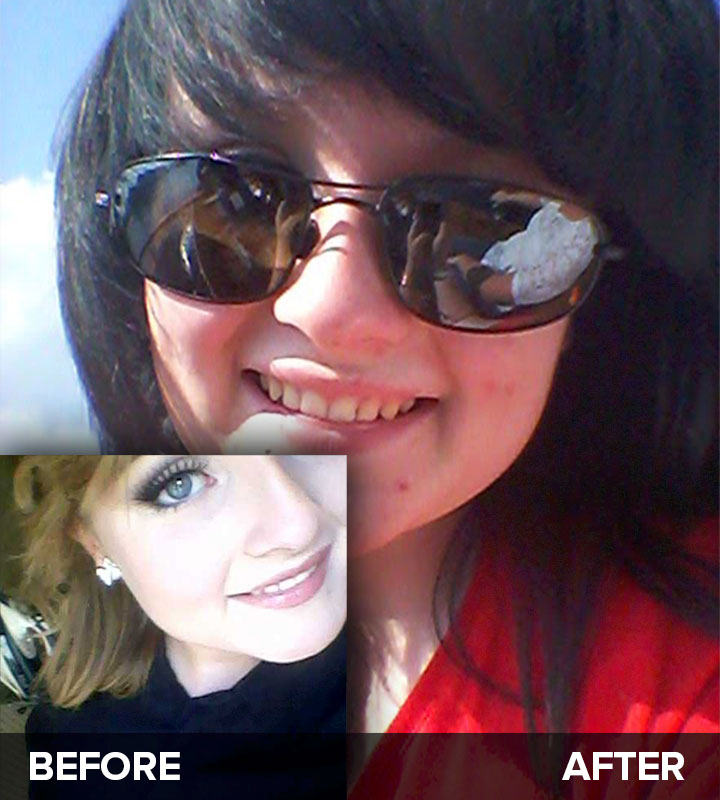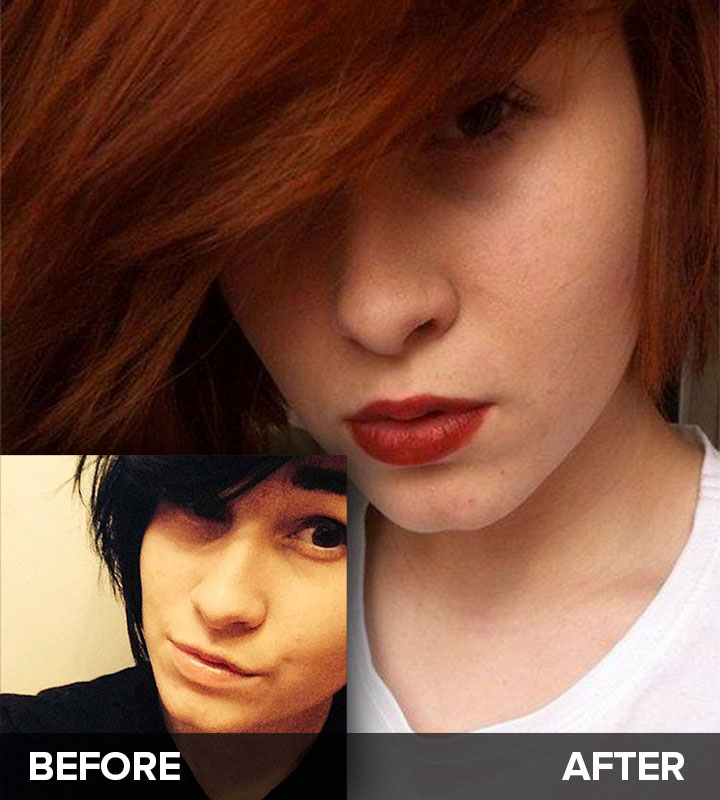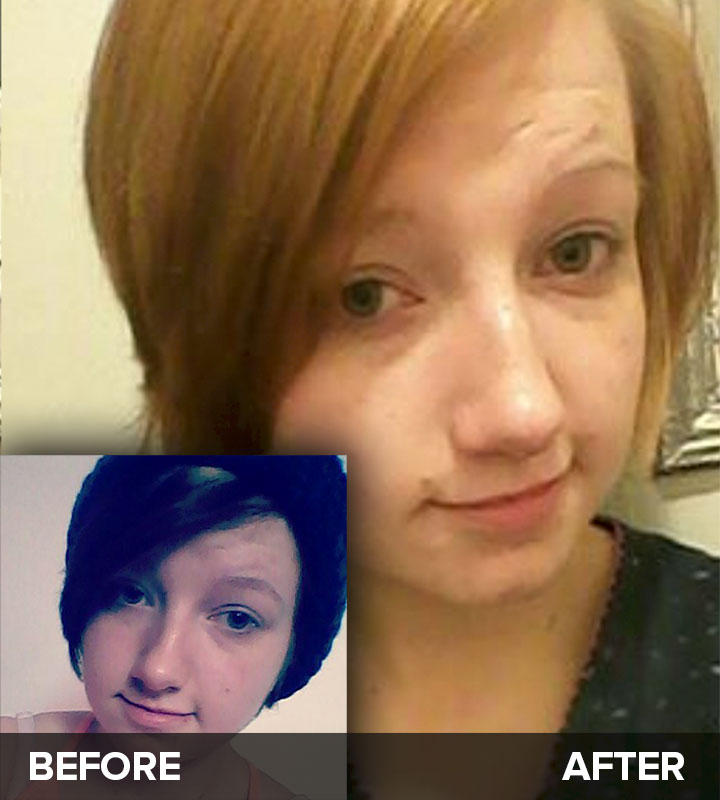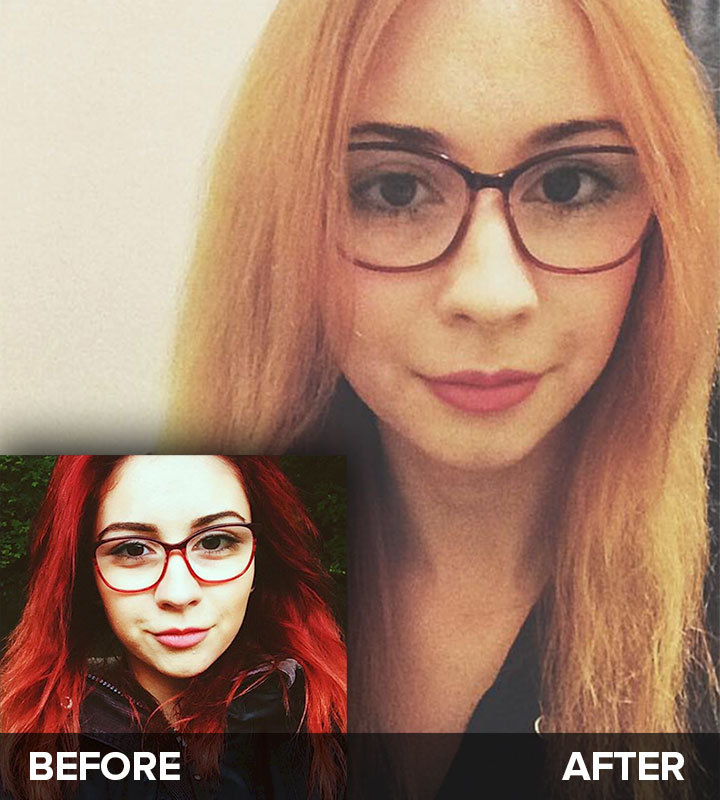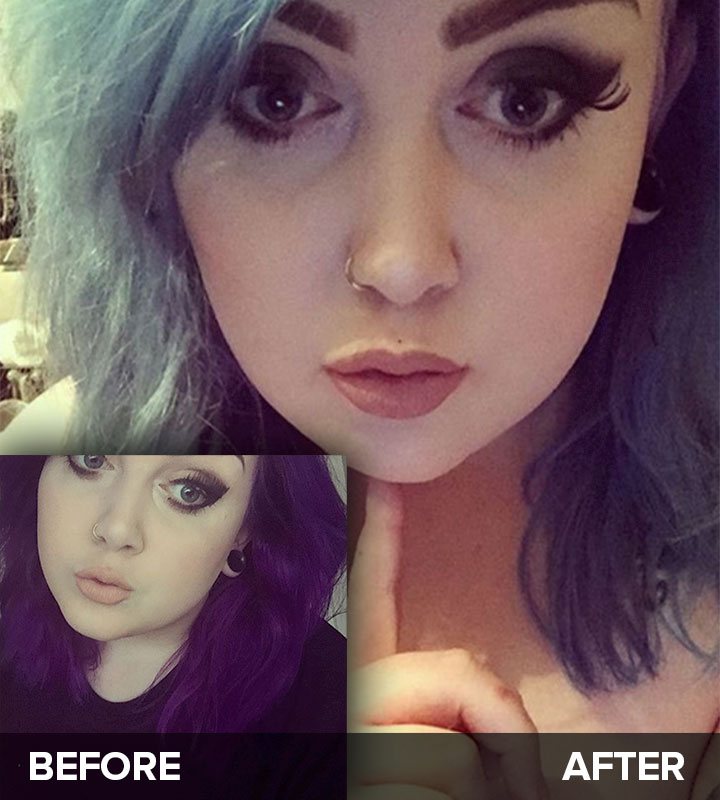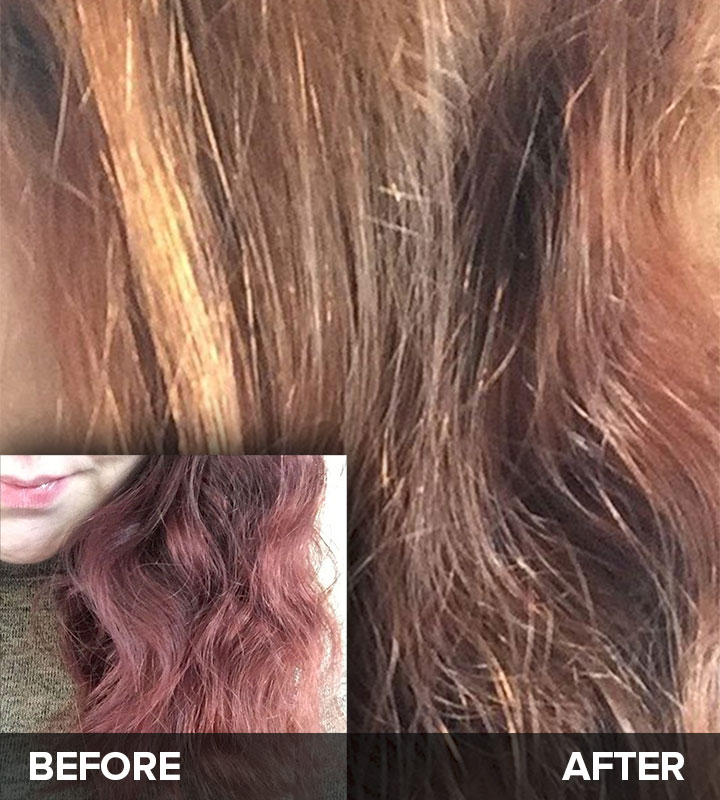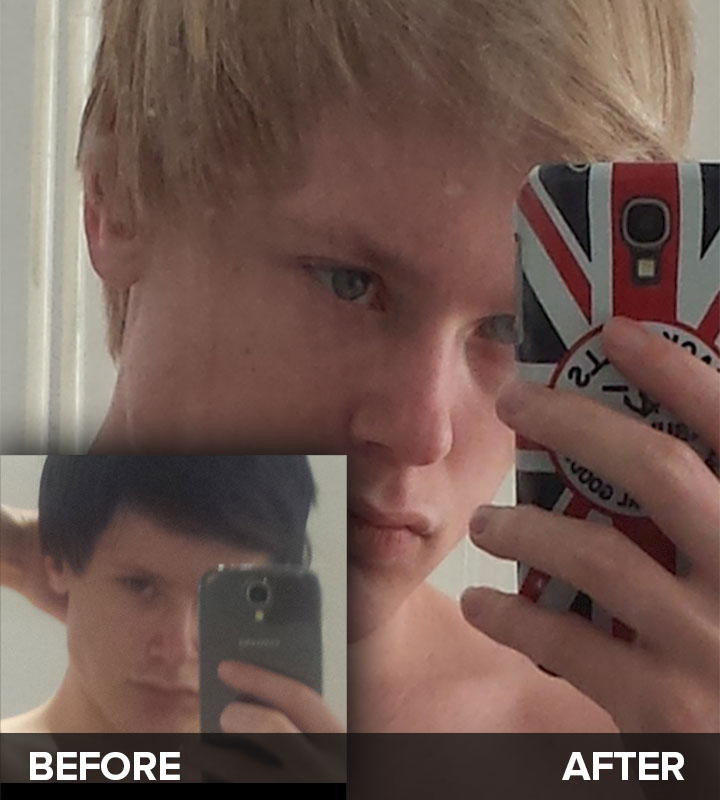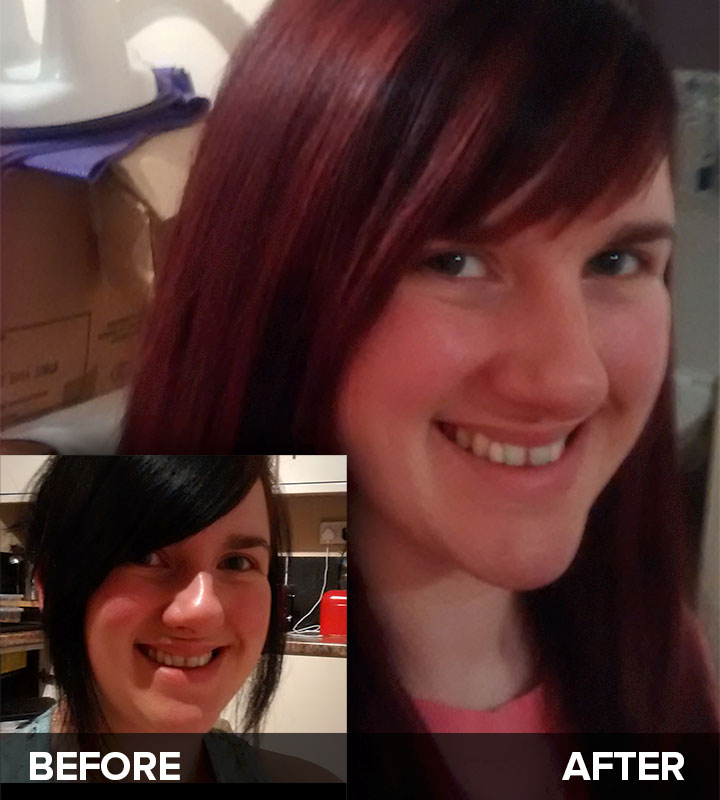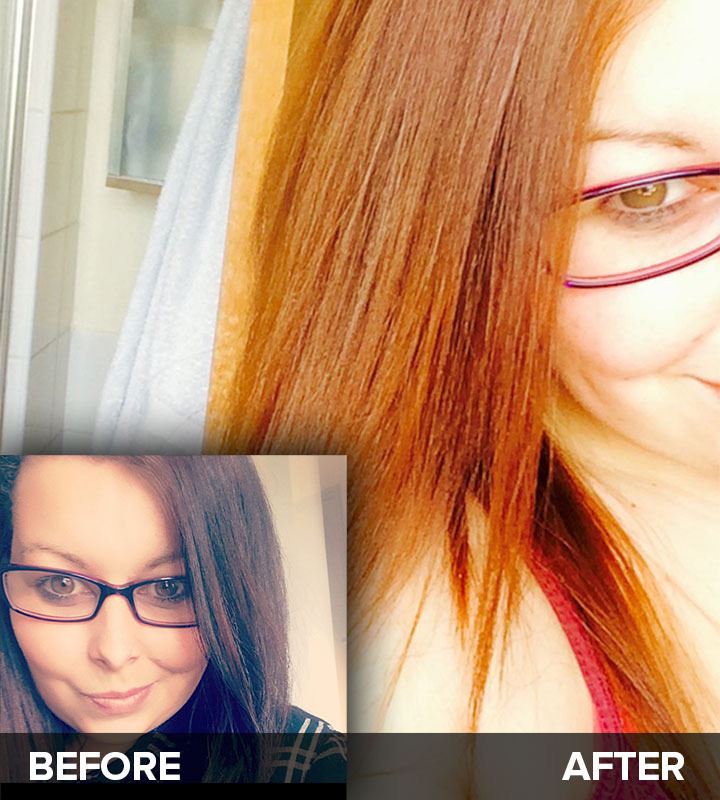We advise you always read the instructions booklet fully before any application, but we have listed the most frequently asked questions below which may help you with your application. You can download instructions below
"Many people see the finish effects of a dye and think that is it,"
says Mandy Baldwin, colour consultant and Trichologist. "But, the effect of the dye on your actual hair pigments, particularly for those lightening their hair isn’t evident to the naked eye. Ammonia strips the pigment from your hair so even with a hair colour remover the original virgin colour may not return as natural pigments have been stripped by the dye itself." There are four natural pigments in the hair. Black and Brown hair is created by melanin pigments and red and blonde hair is created by Pheomelanin pigments. These natural pigments are produced by cells known as melanocytes. The hairs natural colour depends on the ratio of pigment present, and the quantity and mixture.Mandy Baldwin
Your questions, answered
Colourless is formulated to gently remove unwanted permanent oxidised synthetic pigment dyes without stripping or bleaching, and is not intended to be used on hair dyed with non-oxidative pigment semi, demi or direct dyes.
Your original bleached highlights pigments responded as a yellow pigment to the dye 7 ash blue pigment, thus Yellow + Blue = Green (khaki). The bleached hair snapped up the base 5 dye molecules confirms your hair is porous due to the years of bleaching. To decide which colour shade base and tone to use depends on the result you are left with after using the Colourless. Thus if as you say the hair turns out orangey-red then as you desire a chocolate this would be an advantage as in the hair colour chocolate is considered a warm (reddish) shade. When hair has been bleached over a period of time it requires missing molecule spaces to be filled with a pre-pigment usually a red. This fills the gaps to stop colour grab and to stop the hair turning green or neutralising pigments if cool shades are desired. Tick-Tick-brain-ticking now you understand why your hair lifted green the first time. Depending on the how light your hair colour is after using Colourless you may need just a soft copper filler to pre-pigment to stop too much red glaring through the chocolate. Also the chocolate brown dye must be 2 or even 3 times lighter (thus 7 or 8 base) than the final shade you desire. Sounds crazy as these bases are in the blonde range but we need to consider all the hair’s history and how it will respond to the dye molecule. In your case medium blondes will most likely produce a medium to dark brown. I would suggest that you take a cutting of the hair and dye that first to test for both the hair strength and colour result rather than risking the entire hair..
As the hair is bright blonde with orange tones you need an ash based toner. The ash base toner needs to be chosen accordingly to the orange tone you have in your hair. The problem presented here is that you have several colours - ginger, orange and bright blonde. Choosing a toner to neutralise one shade may produce issues for the other shades. Another problem is that we don’t know if the orange is your own dominant red or an underlying synthetic red from a previous product, as this matters. So the option here to stay safe would be (assuming the hair is in good strong condition) to apply bleach to just the orange tones to lift them up to match the shade of the bright blonde you already have in order that all the hair colour is even, then to tone with a violet base toner. If the bright blonde is actually yellowy with orange then a blue/violet toner could be chosen. Now, if you are not really certain then I would suggest trimming off a small sample of your hair and ash semi that sample piece of hair first. Then if the colour is horrible, you will be glad you strand tested the hair first.
You will need additional applications of Colourless. If you are happy with the depth at the roots try just applying Colourless to the black ends only. Then to neutralise out the red tones you will need to apply an ash shade tint or semi. But beware to choose the correct ash. Tinted hair that is red/orange will need a blue/green base and tinted red hair results need green base shade, and orange needs blue. Also you will need to choose shades lighter than you actually desire as it will go darker than expected. Then use a shampoo like Ardell that will help neutralise red gold shades.
When hair looks darker after drying than whilst the Colourless was on the hair this is a sign of re-oxidation. This reaction can happen if the hair has not been rinsed long enough. However as the underlying blonde is starting to peep through it does appear that some of the unwanted dark molecules are now slowly fading. It is okay to apply low peroxide bleach blonde highlights if the hair is in good strong condition. Ask a local hairdresser to tensile strength test the hair first.
I detect you have an underlying lighter dye that was used before or even several times before the final dye. At some point a past underlying dye had lightened your original natural dark tone lifting the natural pigments thus lightening the hair. The light shade was at the time hidden by pigments added by the product to give the desired shade you required at that time. Thus, your original underlying virgin hair had been permanently lightened but then hidden by pigments tones. Colourless has successfully removed the unwanted synthetic pigments from not just the last colour but also from the underlying colours too. Your question regarding applying another box of Colourless I am afraid is not the answer as your virgin shade has been removed. I would suggest you look to choose a base brown shade that closely matches your original shade. If the hair is very dry or porous then choose a colour a little lighter than you desire as it will go darker than the colour chosen due to the hair porosity.
Colourless is formulated to gently remove unwanted permanent oxidised synthetic pigment dyes without stripping or bleaching, and is not intended to be used on hair dyed with non-oxidative pigment semi, demi or direct dyes.
Immediately, due to the Buffer step (Part C) the hair is left at a suitable pH level for safe re-colouring. However, there are several factors which come into play that can dictate how well your next colour application develops. If your previous hair colour application (or applications) have made your hair porous this will become evident after using Colourless™. If you wish to apply a new colour application to porous hair, always select a non peroxide semi-permanent product and apply to wet hair, checking the colour’s development every few minutes. Porous hair will grab colour faster. To achieve the best results after using Colourless™, always re-colour with a Level 1 temporary (or true semi) hair colour in your desired shade, and rest the hair for several weeks before applying the permanent (peroxide based) alternative/variant. This allows the porosity in your hair to normalise and take permanent colour evenly.
Colourless contains no harsh chemicals such as peroxide, bleach and ammonia so it is safe to use during pregnancy. We recommend you consult your GP if you have any concerns about your specific Wellbeing, particularly in the early months (first 12 weeks) of pregnancy.
Absolutely. Colourless™ is a home colour correction system. Once you have removed your unwanted dark colour you can immediately ask your salon to re-highlight your hair as they would normally. There is no reason why there should be any conflict and the cost should be exactly the same as you would pay normally for a highlight service.
Try a tonal cleansing with Colourless™ Regular. With this method, you mix the product but only apply 1/3 of the bottle to damp hair. Comb the product through and develop for 10 minutes (rather than the standard 60) and rinse and buffer the hair just as instructed (for regular colour removal). This method of Colourless™ removal is very weak but ideal for removing unwanted tone in blonde hair.
Colourless™ won’t make your hair condition (necessarily) any worse, but it won’t make it any better either. You can use Colourless™ but do not apply a permanent colour immediately afterwards. You need to rest the hair. Instead opt for a Level 1 temporary 6 wash colourant (which contains no peroxide or ammonia) and use this in your hair for 4 weeks. Give your hair frequent conditioning treatments too. If after 4 weeks your hair feels in better condition you can upgrade the Level 1 temporary colour to a level 2 or 3 permanent or semi-permanent colour. If you do apply a permanent hair colour to dry, porous hair the result may well be darker and more intense than you desired and it could require another colour removal application, so always rest the hair and get that condition back.
Colourless™ hasn’t bleached your hair, even though you haven’t had highlights in over a year the evidence of them is still present. Colourless™ has simply revealed this old hair. If you want to tone down the blonde ends, apply a semi-permanent hair colour 2 shades lighter than your natural (or re-growth) colour and apply to the blonde areas only. The result will be a soft version of your natural colour.
Keratin treatments are a great way to remove frizz and smooth the hair cuticle. It is a temporary treatment effect that gradually leaves the hair over 3 to 6 months (depending on the keratin treatment used). The protein keratin contains cysteine disulfide which forms disulfide bridges that are very strong and difficult to penetrate. This therefore would most likely result in an uneven patchy colour removal result. It is however possible to remove the protein keratin to encourage an even Colourless removal result. To remove the protein keratin barrier use a shampoo with Sodium such as Sodium Lauryl Sulfate as this has the ability to break down the keratin. For hair that has a build-up of protein keratin add a table spoon of salt (sodium chloride) to two or three table spoons of the shampoo. Wash the hair two of three times each day until the hair has returned back to its original wave movement, this may take up to a couple of weeks. Some permanent keratin straightening treatments are organic and do not contain chemicals such as thioglycolates, sodium hydroxide ammonia, formaldehyde or animal derivatives. These are based on plant keratin which is safer and kinder to the hair. The amino acid cystine is the permanent straightening agent and keratin is the protein that gives the hair shaft its strength. For these we could suggest waiting up to 4 weeks and suggest a strand test.
It’s very simple to correct - apply Colourless Extra Strength to the mid lengths and ends of her hair. This should remove the build-up of previous dye molecules. This will lift the hair to match the colour nearer the roots. If your colour build-up is very severe then you may need to repeat the process.
That would work but it is a long way to reach the goal. The problem that arises on white hair is that red shades tend to result in oranges and pinks whereas ash shades tend to result in dull green shades. The correct choice should be to use a product that contains both a base with a tone accordingly to the final result desired. In your case you need to choose a dye that is specifically made with both the brown base and a red tone to the shade you desire. If you are unable to find the shade you desire in a ready mixed formula then choose a brown to the depth you like then a red that you like ensuring they are both the same brand and range mix equal parts 50-50. For a deep shade “red black” try Schwarzkopf poly tint colour, for either cherry or ruby red try Extreme ‘N’ Easy by Clairol - both cover 100% grey hair.
This sounds like colour build up. When a permanent hair colour has been overlaid on the hair with multiple applications it can take longer to remove. You may want to try Colourless™ on the ends only (processing to the full 60 minutes). Alternatively, if the dark colour is only on the very ends (the last inch or so) it is far easier to not apply another Colour removal – but instead just have the old colour cut out.
In theory you can (if you haven’t re-coloured afterwards). The After Treatment Buffer will leave your hair at a suitable pH to take a perm or straightening satisfactorily. However, both perms and straightening treatments are very stressful to the hair. It is advisable you wait at least two weeks before you undertake them after using Colourless™.
Firstly, very dark colours may require more than one Colourless™ application as there is a great deal of artificial pigment which needs to be removed. Secondly the cuticle of bleached blonde or porous hair can stain if a black colourant is laid onto it. In severe cases this staining can prove impossible to remove. Unfortunately, you can only judge how much staining has occurred and how much pigment can actually be removed by conducting a maximum of three Colourless™ applications. After this, if dark staining is still present it may be necessary to grow the colour out. Bleaching can remove some stains – but seek professional expertise if you choose this option.
Because that Ginger colour IS your hair colour. When brown hair is subjected to the peroxide in lightening colourants it too will lighten and reveal a great deal of warmth. Because your hair was lightened that warm colour you are seeing is actually your natural hair colour pigment. To remedy, you need to apply a hair colourant which is the same shade as your (original) natural colour. Because this will be darker (as your hair was previously lightened) it will cover the exposed warm pigment. Alternatively – try a semi-permanent shade the same depth as your exposed colour – but with ash tone. This may neutralise out the unwanted warmth you can currently see.
When changing a hair colour you need to be 100% certain you are happy with the shade you have selected. Many permanent colours give hard, dramatic results – if you are not happy with these results you will need to undertake another colour correction (using Colourless™) to rid them. When hair has been continually coloured it can be porous and absorb future peroxide based hair colours like a sponge causing a darker (than expected) result. After using B4 it’s far better to ‘rest’ the hair for at least a week and allow the hair to normalise (as you would do after a perm or straightening). If you would like to use a semi-permanent (peroxide based) colour after using Colourless, firstly condition well and then apply the colourant to damp towel dried hair – this evens porosity and reduces the risk of colour grabbing. When ‘resting’ the hair after using Colourless it’s preferable to use six wash temporary shades (also known as 1 bottle/Level 1 colourants).. These ‘wash in’ colourants contain no harsh chemicals (so hair needs re-colouring every six washes). If your hair feels particularly dry after colour correcting, simply use these temporary products until the condition has returned and re-colour using a semi-permanent (level 2) or permanent (level 3) product. Usually a month is a good time to rest very dry hair.
Although not exclusively the case, this can occur due to product build up on the cuticle or silicone damage from previous products and colourants. If the hair is coated in heavy conditioners, waxes, shampoo residues and styling aids, Colourless™ simply cannot penetrate the cuticle and get to the artificial colour molecules. This is why it’s always advisable to wash your hair several times with a build up removing shampoo prior to applying Colourless™ to dry hair. The other reason lack of removal occurs is due to silicone damage. Although many hair products and colourants use silicones these are (in general) completely harmless to the hair. However, if the hair is regularly subjected to heated appliances such as tongs and irons over 230 degrees the silicone can reach boiling point and melt. The silicone then re-hardens and encases the hair in a plastic shell. Hair which has suffered silicone damage has a flat, synthetic shine appearance and commonly the ends will be fluffy or frizzy. Unfortunately there is nothing that can remove this silicone and the affected hair has to be grown out. To avoid this happening in the future, do not use high temperature heats on products which claim to be ‘anti fade’, ‘fade resistant’, ‘water proof’, ‘shine enhanced’ or ‘colour locking’. All of these phrases pertain to use of silicone. In general they give great results but you must not use incredibly high heats on or above 230 degrees in conjunction with them.
You can use Colourless again immediately; sometimes colour build up will require more than one application to remove heavy build up. It’s safe to use Colourless several times over to receive necessary removal.
Colourless contains no peroxide or bleaches and is unable to lighten the hair in any way, it can only work on the artificial colourant molecules inside the hair. However, any peroxide based permanent and semi permanent colourants can lighten away the natural hair colour. Even products which are branded as semi permanent can (on occasion) lighten the hair. The more you apply a peroxide based colourant to the hair, the more likely it is your own (natural) colour has been permanently and irreversibly removed. You will not notice this lightening until you attempt to remove the colour at which point it is exposed. You need to be aware (if you are brunette or darker blonde based) and finding your hair colour constantly has a & warm hue to it, that its very possible your natural colour has been removed by peroxide application. In these cases you will see a lightened or copper result when you apply Colourless. Remember, Colourless is merely designed to remove artificial hair colour to give you a fresh canvas to work from. Its quite workable if you find you have a copper result, all you need to do is apply an ash based Level 1 colourant (such as Nice and Easy 8 wash no peroxide of ammonia) and this will neutralise the warmth and give you a natural (even) result. After a week (of resting the hair) you can apply an ash based traditional semi or permanent hair colourant to achieve a long term result.
This is called re-oxidation and this means the artificial colour molecules were not flushed fully from the hair during the removal process and have enlarged and caused the previous colour to return. This can happen due to several factors, but it can quite often mean a second application of Colourless is necessary. Its preferable you wait at least 72 hours before doing this subsequent application to make sure any reoxidation has completely occurred before your next application of Colourless.
The good news is that you can safely use Colourless as many times as you wish within sensible guidelines! Colourless does not contain bleach or ammonia unlike the harsh chemicals that you find in other hair products and in particular hair colourants. It is for this reason we do not advise colouring your hair too often. Every time you use a colourant you risk lightening your natural pigment with the bleached contained in many of the colour ranges. We also recommend that you rest your scalp between chemical processes, after using a colourant and/or Colourless. We recommend you rest your scalp for a week before undertaking the next process be that colouring or colour removal.
Before you use the Colourless process it is strongly recommended to achieve the best possible removal that you start with clean dry hair. We recommend that you wash your hair twice with a clarifying shampoo to remove product residue and silicone build-up from the cuticle. This will help to prevent 'patchy colour', root glow and colour build-up. It will also remove any temporary colours.
Firstly Colourless will work on human/real hair extensions if they have not been bleached/highlighted.However the human hair they use has been treated and stripped of it’s cuticle. If you apply Colourless it will also remove the natural hair colour they applied in the first instance and be left with a coppery orange shade.
If you are completely grey and/or white, there is no colour to reveal. The colour that you return to is therefore unpredictable. The colourant you’ve been using will most likely cause cuticle staining that will be the predominant colour that you return - there are other variables that can affect the colour like your hair porosity, the silicone in your hair and build-up from product residue at the tips
We recommend you rest your hair and scalp for a week before highlighting. Although Colourless contains no harsh chemicals like bleach, peroxide and ammonia, it is however a chemical treatment and you should always rest your hair before the next product application.
Cuticle staining is when too much colour pigment has been forced into bleached,grey or porous hair after multiple colourings of high fashion bright colours and then can never be removed effectively again with Colourless or bleach.*Please note that cuticle staining may/may not always occur it all depends on the condition of your hair.There is no harm in giving Colourless a go, just please do a strand test first.
Colourless is only designed to remove artificial colour molecules from the hair, so it will not effect your natural hair colour in anyway
Well firstly we need to establish if you’ve been applying high heats to your hair during the 5/6 months you have been using this Schwartzkopf colour. When Colourless was launched there was feedback that Colourless was having no effect on Schwarzkopf Live XXL black, so It was put to the test using Regular Strength Colourless and it removed it from the hair without any problems. However, this Schwarzkopf product is called ‘water resistant’ which means they have loaded it with silicone. This means you won’t have problems unless you have been applying high temperatures to your hair with irons in which case the silicone melts and traps the colour molecules inside the hair. Another factor (which can prevent Colourless from working) is regular use of certain types of shampoos. Some famous shampoos contain high levels of silicone which create a barrier on the hair and prevent any other chemical product from working. A good tip (before you next apply Colourless) is to buy a build up removing shampoo, some bicarbonate of soda and some lemon juice. Wash your hair several times with the build up removing shampoo and then mix up 1 tablespoon of the lemon juice and 1 tablespoon of bicarb in a cup and apply it to your wet hair, comb through and leave for about 5 minutes. Then remove with the build up shampoo. This above method can break down any build up on your hair surface and open your cuticle which will enable Colourless to get into your hair. If you have got a lot of excess silicone in and on your hair you want to try and get rid of that as best you can.
You suffer from sensitive skin or are prone to allergy, a preliminary patch test is recommended. Mix a pea sized amount of Part A and an equal amount of Part B. Using a cotton bud or tissue apply a dab of the mixed product behind the ear. Remove after 24 hours with water and a cleanser. Remove immediately if irritation occurs. If irritation or a reaction is apparent do not conduct a Colourless application.
It is essential that you undertake a strand test to view your potential results before you apply the entire contents. If you wish to preview results (prior to full head application) conduct a strand test using a small section of hair no more than a centimetre in width. Mix equal parts of A and B (in pea sized amounts) and apply with a cotton bud or tissue to segregated hair. Fully saturate and leave to develop for 30 minutes (Regular Strength) or 60 minutes (Extra Strength). Rinse for five minutes, dry and check result. DO NOT APPLY POST TREATMENT BUFFER (Part C ) to hair when strand testing as it could affect results of a subsequent whole head application of Colourless.
Products

BUY NOW!
Subscribe to our Newsletter
Address
Stalham Business Park, Rushenden Road, Queenborough, Kent ME11 5HE









